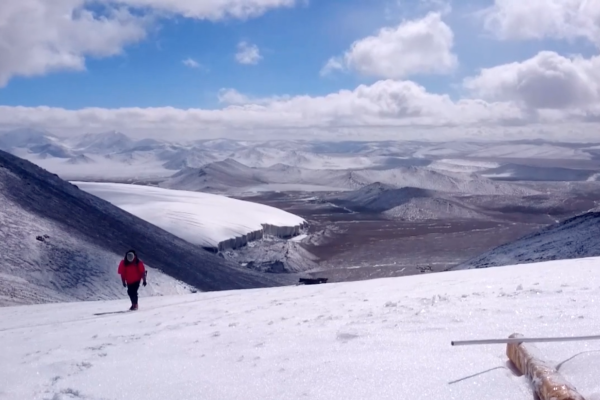Orbital-Scale Climatic Shifts on the Northwest Tibetan Plateau: Insights from Ice Core Data

The recent warming trend since the mid-20th century poses a significant threat to the glaciers and ice sheets on the Tibetan Plateau. While glaciers in the Himalayas and the southern part of the Tibetan Plateau have been retreating at increasing rates over the last 50 years, those in the Northwest Tibetan Plateau (NwTP) have remained stable or even gained mass until very recently due to increasing precipitation and a brief hiatus in regional warming.
Since 2015, this regional trend of increasing ice accumulation has stopped and even reversed. Recent studies predict that in response to the rapid warming in High Asia, the region's glaciers will likely lose between 49% and 64% of their mass by the end of the 21st century if global temperatures rise by 1.5°C.
A recent study published in Quaternary Science Reviews focuses on the upper 187.4-meter section of a 309.7-meter ice core extracted from the Guliya ice cap, which is part of a large ice sheet located in the western Kunlun Mountains near the northwestern boundary of the Tibetan Plateau. Analysis of the upper 60% of this ice core has produced a 41,000-year record of orbital-scale (>10,000 years) and millennial-scale climate variations in the NwTP, a region deficient in detailed paleoclimate data.
Measurements made on the ice core include oxygen isotopic ratios (δ18O), a potential temperature indicator, and ammonium and dust concentrations, which provide information about regional and local aridity. The timescale was developed with the aid of two cosmogenic isotopes, chloride-36 and beryllium-10, which were measured throughout the length of the core. From these measurements, a ~41,000-year-old geomagnetic excursion known as the "Laschamp event" that was previously detected in polar ice cores was observed in the Guliya ice core. The ~41,000-year-old ice found 122.3 meters above the bottom of the ice core, coupled with the fact that ice compresses exponentially with depth, strongly suggests that the 309.7-meter-long Guliya ice core may contain the oldest ice recovered outside the polar regions.
Influencing factors leading to changes in the climate of the NwTP over millennia include the size of the large ice sheets covering the high latitudes of the Northern Hemisphere during the last glacial period, variations in Northern Hemisphere summer insolation (incoming solar radiation), and meridional shifts in the Intertropical Convergence Zone, the region of high precipitation near the equator where the northeast and southeast trade winds converge. These factors are crucial in determining the position and intensity of the westerly winds through Central Asia and the Asian Monsoon system, which both impact the Tibetan Plateau and South Asian climate.
The Guliya ice core record reveals that during the glacial period (~41,000 to ~17,500 years ago), the climate (i.e., temperature and precipitation) on the NwTP was significantly influenced by orbital-scale variations in the intensity of the summer insolation. Changes in δ18O of the ice, potentially indicating temperature, corresponded directly with changes in insolation. During this period, the ice core-derived δ18O records from NW Tibet and Greenland show similar patterns, indicating a broader, synchronized climatic trend across these regions. In addition, millennial-scale cold intervals called Heinrich Events, visible in δ18O records from Greenland ice cores, are also observed in the Guliya δ18O record. Thus, during the glacial period, long- and short-term climate linkages existed between the North Atlantic and the NwTP.
Throughout the deglaciation phase (17.5–12 ka BP), when the Northern Hemisphere ice cover retreated, summer insolation continued to influence temperature on the NwTP significantly. However, the North Atlantic's impact on the NwTP climate declined as the westerlies and the Indian summer monsoon migrated northward. During this period, the δ18O variations in the Greenland and Guliya ice cores switched from corresponding to opposing trends. Although the temperature (δ18O) record from the Guliya ice core is broadly similar to the record of summer insolation during the glacial and deglacial periods, during the Holocene epoch, the ice core δ18O and summer insolation trends diverge.
This suggests that temperature's influence on δ18O values weakened while the influence of moisture sources and pathways, particularly from the encroaching Indian monsoon, became more important. In other words, the factors influencing δ18O values in NW Tibet appear to vary as a function of the competing influences of the monsoon from the south and the westerlies that originate in the North Atlantic. However, during the most recent 8000 years, temperature appears to have assumed a more dominant role in determining the δ18O values, although the rising temperatures may also have been linked more strongly to increasing greenhouse gas concentrations than to solar influences.
Further research is underway to understand the atmospheric and hydrospheric processes affecting δ18O in precipitation in the NwTP, as well as the transient relationships between boundary conditions and the climate of this region, located along a shifting border between competing air masses.
Lead authors of the study are Byrd Center Senior Research Scientists and Distinguished University Professors at The Ohio State University, Lonnie Thompson from the School of Earth Sciences, and Ellen Mosley-Thompson from the Department of Geography.
This research was an international collaboration that included Professor Tandong Yao from the Chinese Academy of Sciences (CAS), who also co-chairs the Third Pole Environment with Lonnie Thompson. Other researchers included Hans Arno Synal and J. Beer from ETH Zürich, Guangjiang Jian Wu from CAS, and Byrd Center members Mary Davis, Joh Bolzan, Stanislav Kutuzov, Émilie Beaudon, and Roxana Sierra-Hernández.
Learn more by visiting the publication or downloading the PDF.
